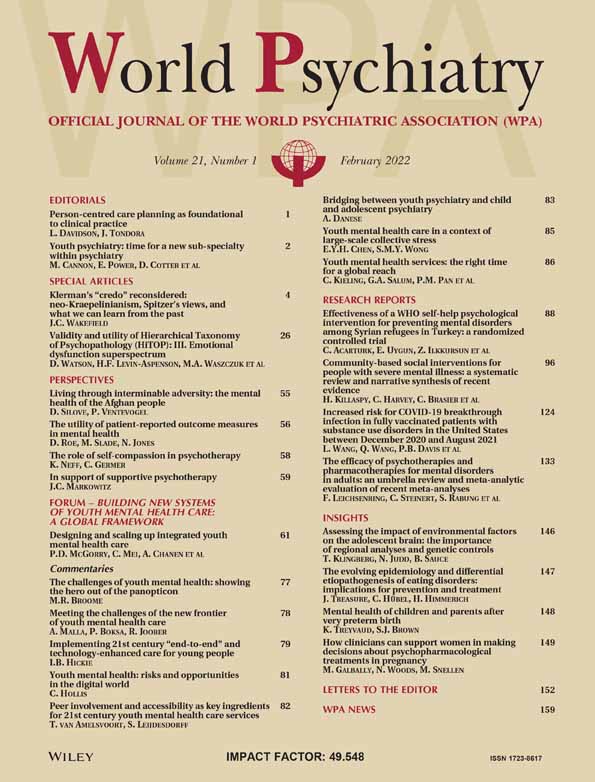Where do neurodevelopmental conditions fit in transdiagnostic psychiatric frameworks? Incorporating a new neurodevelopmental spectrum
IF 65.8
1区 医学
Q1 Medicine
引用次数: 0
Abstract
Features of autism spectrum disorder, attention-deficit/hyperactivity disorder, learning disorders, intellectual disabilities, and communication and motor disorders usually emerge early in life and are associated with atypical neurodevelopment. These “neurodevelopmental conditions” are grouped together in the DSM-5 and ICD-11 to reflect their shared characteristics. Yet, reliance on categorical diagnoses poses significant challenges in both research and clinical settings (e.g., high co-occurrence, arbitrary diagnostic boundaries, high within-disorder heterogeneity). Taking a transdiagnostic dimensional approach provides a useful alternative for addressing these limitations, accounting for shared underpinnings across neurodevelopmental conditions, and characterizing their common co-occurrence and developmental continuity with other psychiatric conditions. Neurodevelopmental features have not been adequately considered in transdiagnostic psychiatric frameworks, although this would have fundamental implications for research and clinical practices. Growing evidence from studies on the structure of neurodevelopmental and other psychiatric conditions indicates that features of neurodevelopmental conditions cluster together, delineating a “neurodevelopmental spectrum” ranging from normative to impairing profiles. Studies on shared genetic underpinnings, overlapping cognitive and neural profiles, and similar developmental course and efficacy of support/treatment strategies indicate the validity of this neurodevelopmental spectrum. Further, characterizing this spectrum alongside other psychiatric dimensions has clinical utility, as it provides a fuller view of an individual's needs and strengths, and greater prognostic utility than diagnostic categories. Based on this compelling body of evidence, we argue that incorporating a new neurodevelopmental spectrum into transdiagnostic frameworks has considerable potential for transforming our understanding, classification, assessment, and clinical practices around neurodevelopmental and other psychiatric conditions.神经发育状况在跨诊断精神病学框架中的定位?纳入新的神经发育谱系
自闭症谱系障碍、注意力缺陷/多动障碍、学习障碍、智力障碍以及交流和运动障碍的特征通常在生命早期出现,并与不典型的神经发育有关。DSM-5 和 ICD-11 将这些 "神经发育疾病 "归为一类,以反映它们的共同特征。然而,依赖于分类诊断在研究和临床环境中都会带来巨大的挑战(例如,高并发性、任意的诊断界限、疾病内部的高异质性)。采用跨诊断维度的方法为解决这些局限性、解释神经发育性疾病的共同基础以及描述其与其他精神疾病的共同发生和发展连续性提供了一个有用的替代方案。尽管神经发育特征对研究和临床实践有着根本性的影响,但在跨诊断的精神病学框架中,神经发育特征尚未得到充分考虑。对神经发育性疾病和其他精神疾病的结构进行研究后发现,越来越多的证据表明,神经发育性疾病的特征聚集在一起,形成了一个 "神经发育谱系",其范围从正常到受损都有。对共同的遗传基础、重叠的认知和神经特征、相似的发育过程和支持/治疗策略的有效性进行的研究表明,这一神经发育谱系是有效的。此外,将该谱系与其他精神病学维度一起描述具有临床实用性,因为它能更全面地反映个体的需求和优势,并且比诊断类别更具预后效用。基于这些令人信服的证据,我们认为,将新的神经发育谱纳入跨诊断框架,对于改变我们对神经发育性疾病和其他精神疾病的理解、分类、评估和临床实践具有相当大的潜力。
本文章由计算机程序翻译,如有差异,请以英文原文为准。
求助全文
约1分钟内获得全文
求助全文
来源期刊

World Psychiatry
Nursing-Psychiatric Mental Health
CiteScore
64.10
自引率
7.40%
发文量
124
期刊介绍:
World Psychiatry is the official journal of the World Psychiatric Association. It aims to disseminate information on significant clinical, service, and research developments in the mental health field.
World Psychiatry is published three times per year and is sent free of charge to psychiatrists.The recipient psychiatrists' names and addresses are provided by WPA member societies and sections.The language used in the journal is designed to be understandable by the majority of mental health professionals worldwide.
 求助内容:
求助内容: 应助结果提醒方式:
应助结果提醒方式:


